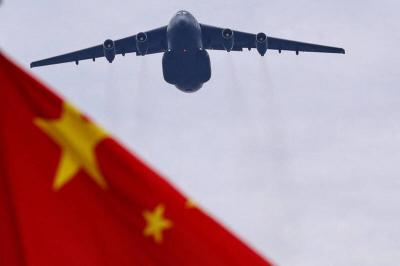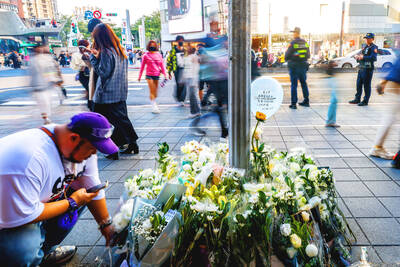For 73-year-old Tung Hsiang-ming (湯祥明), Lunar New Year is not a time for family reunions. Since he was sent to the Happy Life Leprosy Hospital in Sinjhuang, Taipei County, in 1951, Tung has spent each holiday with other lepers in the once secluded sanatorium. Still, hot-pot dinners and red envelopes brought some joy to Tung and his fellow patients. This year, however, was different.
Fears of relocation to a new hospital facility -- one with iron-barred windows -- has marred their happiness.
In 2003, Taipei County officials began demolishing the 70-year-old hospital community built under Japanese colonial rule to make room for the Taipei Mass Rapid Transit (MRT) system's Xinshuang Line.
Banyan trees were uprooted, elegant Japanese-styled houses were torn down, and old patients were moved from their homes to prefabricated sheds.
With negotiations with the government appearing less and less fruitful, the frustrated patients knew that soon the rest of the complex would be razed to the ground.
For Tung and other 300 lepers, the demolition of Happy Life was the most unwelcome news for the Lunar New Year.
"When the society turned its back on me and ostracized me in the 1950s, I found peace here at Happy Life. Happy Life is my home and the other patients are my family. I don't want to move," Tung said, sitting in a small pre-fab shanty crammed with a plank bed, TV set, tabletop gas burner and cooking utensils.
For many other lepers, the Happy Life is not just a verdant hospital complex. It is a place where they lived out the pain of parting with their families and where they survived the devastations of leprosy. It is home.
Since many of the older patients were cut off from society and their families decades ago, they now have few ties to the outside world.
Huang Jing-liang (
"I've lived here for more than 60 years without contact with my family. If Happy Life is not my home, what is?" the 75-year-old Huang said.
For these people, the new Huilung Community Hospital, where the Taipei County Government plans to relocate them, can never replace Happy Life.
For the government, however, the MRT project is crucial.
When the Vice President Annette Lu (
"If patients refuse to move to the new hospital, the hospital should improve its facilities and listen more to the patients," Lu said.
"However, the MRT is a nationally significant project. Once such an important project is delayed, the nation will lose a considerable amount of money. Who is going to pay for this?" she said.
According to the county government, changing the route of the Xinshuang MRT line in order to preserve Happy Life would cost more than NT$2 billion (US$63 million) and delay the project's completion by more than three years.
But are the MRT line and patients' rights mutually exclusive? Many city planning experts believe not.
"It is possible to preserve Happy Life as historical and cultural site with the MRT trains running past it. It could be a shared space for modern technology and historical heritage," said Hsia Chu-joe (
If the Taipei County Government and construction companies can move the power plant and water treatment plant from the original hospital complex, Hsia said, the 70-year-old hospital would not have to be dismantled and its patients forced to move.
To seek a solution, the Executive Yuan invited experts to study alternative plans for the MRT line and the hospital last October.
The panel of experts submitted its report to the Executive Yuan last month, suggesting the government both preserve the patient wards and continue construction of the MRT line.
"The panel said that it will only cost NT$300 million to change the route, instead of the NT$2 billion the government claims," said Wu Jia-zhen (
In Wu's eyes, the extra expense is a price the government should pay to redeem the wrongs made 11 years ago.
"The government was wrong when they failed to consider the 300 patients living at Happy Life and rashly mapped out the routes of the Xinshuang MRT line in 1994," Wu said.
"How could they decide to tear down Happy life without the patients' consent and an assessment of its cultural and historical values?" the rights activist said.
For the long-forgotten patients, the pain of being eaten away by their affliction has now long passed. Blindness, deafness, loss of fingers, above-the-knee amputations and wooden limbs do not bother them any more.
"We now only hope to live out our lives here," said Chen Zai-tien (

Beijing could eventually see a full amphibious invasion of Taiwan as the only "prudent" way to bring about unification, the US Department of Defense said in a newly released annual report to Congress. The Pentagon's "Annual Report to Congress: Military and Security Developments Involving the People's Republic of China 2025," was in many ways similar to last year’s report but reorganized the analysis of the options China has to take over Taiwan. Generally, according to the report, Chinese leaders view the People's Liberation Army's (PLA) capabilities for a Taiwan campaign as improving, but they remain uncertain about its readiness to successfully seize

HORROR STORIES: One victim recounted not realizing they had been stabbed and seeing people bleeding, while another recalled breaking down in tears after fleeing A man on Friday died after he tried to fight the knife-wielding suspect who went on a stabbing spree near two of Taipei’s busiest metro stations, Taipei Mayor Chiang Wan-an (蔣萬安) said. The 57-year-old man, identified by his family name, Yu (余), encountered the suspect at Exit M7 of Taipei Main Station and immediately tried to stop him, but was fatally wounded and later died, Chiang said, calling the incident “heartbreaking.” Yu’s family would receive at least NT$5 million (US$158,584) in compensation through the Taipei Rapid Transit Corp’s (TRTC) insurance coverage, he said after convening an emergency security response meeting yesterday morning. National

Taiwan has overtaken South Korea this year in per capita income for the first time in 23 years, IMF data showed. Per capita income is a nation’s GDP divided by the total population, used to compare average wealth levels across countries. Taiwan also beat Japan this year on per capita income, after surpassing it for the first time last year, US magazine Newsweek reported yesterday. Across Asia, Taiwan ranked fourth for per capita income at US$37,827 this year due to sustained economic growth, the report said. In the top three spots were Singapore, Macau and Hong Kong, it said. South

PLANNED: The suspect visited the crime scene before the killings, seeking information on how to access the roof, and had extensively researched a 2014 stabbing incident The suspect in a stabbing attack that killed three people and injured 11 in Taipei on Friday had planned the assault and set fires at other locations earlier in the day, law enforcement officials said yesterday. National Police Agency (NPA) Director-General Chang Jung-hsin (張榮興) said the suspect, a 27-year-old man named Chang Wen (張文), began the attacks at 3:40pm, first setting off smoke bombs on a road, damaging cars and motorbikes. Earlier, Chang Wen set fire to a rental room where he was staying on Gongyuan Road in Zhongzheng District (中正), Chang Jung-hsin said. The suspect later threw smoke grenades near two exits